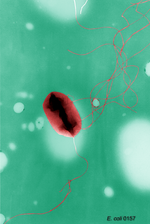鞭毛:修订间差异
删除的内容 添加的内容
无编辑摘要 |
|||
| 第32行: | 第32行: | ||
这三种类型之间的主要区别概括如下: |
这三种类型之间的主要区别概括如下: |
||
* 细菌鞭毛是螺旋细丝,每一个在其基部带有旋转马达可以顺时针或逆时针转动<ref name=Silverman1>{{cite journal |title = Flagellar rotation and the mechanism of bacterial motility |author=Silverman M, Simon M |journal=Nature |year=1974 |volume=249 |pages=73–74| pmid=4598030 | doi = 10.1038/249073a0 |issue = 452}}</ref><ref name=Meister1>{{cite journal |title = Rapid rotation of flagellar bundles in swimming bacteria |author=Meister GLM, Berg HC |journal=Nature |year=1987 |volume=325 |pages=637–640| doi = 10.1038/325637a0 |issue=6105}}</ref><ref name=Berg1>{{cite journal |title = Bacteria Swim by Rotating their Flagellar Filaments |author=Berg HC, Anderson RA |journal=Nature |year=1973 |volume=245 |pages=380–382| pmid=4593496 | doi = 10.1038/245380a0 |issue = 5425}}</ref>。它们提供了几种细菌运动性中的两个运动<ref name=Jahn1>{{cite journal |title = Movement and Locomotion of Microorganisms |author=Jahn TL, Bovee EC |journal=Annual Review of Microbiology |year=1965 |volume=19 |pages=21–58 | pmid=5318439 | doi = 10.1146/annurev.mi.19.100165.000321}}</ref><ref name=Harshey1>{{cite journal |title = Bacterial Motility on a Surface: Many Ways to a Common Goal |author=Harshey RM |journal=Annual Review of Microbiology |year=2003 |volume=57 |pages=249–273 | pmid=14527279 | doi = 10.1146/annurev.micro.57.030502.091014}}</ref>。 |
|||
* 细菌鞭毛是螺旋细丝,每一个在其基部带有旋转马达可以顺时针或逆时针转动。它们提供了几种细菌运动性中的两个运动。 |
|||
* 古菌鞭毛(Archaella)是表面上类似于细菌鞭毛,但是在许多细节上是不同的,并认为是非[[同源]]<ref name=Ng1>{{cite journal |author=Ng SY, Chaban B, Jarrell KF |title=Archaeal flagella, bacterial flagella and type IV pili: a comparison of genes and posttranslational modifications |journal=J. Mol. Microbiol. Biotechnol. |volume=11 |issue=3–5 |pages=167–91 |year=2006 |pmid=16983194 |doi=10.1159/000094053}}</ref><ref name=Metlina1>{{cite journal |author=Metlina AL |title=Bacterial and archaeal flagella as prokaryotic motility organelles |journal=Biochemistry Mosc. |volume=69 |issue=11 |pages=1203–12 |year=2004 |pmid=15627373 |doi=10.1007/s10541-005-0065-8}}</ref><ref name= Jarelletal>{{cite book |author= Jarrell|year=2009|chapter=Archaeal Flagella and Pili|title=Pili and Flagella: Current Research and Future Trends|publisher=Caister Academic Press|isbn= 978-1-904455-48-6 }}</ref>。 |
|||
* 古菌鞭毛(Archaella)是表面上类似于细菌鞭毛,但是在许多细节上是不同的,并认为是非[[同源]]。 |
|||
* 真核生物的鞭毛 -植物,动物和原生生物的细胞的复杂的细胞凸出来回的鞭打。 |
* 真核生物的鞭毛 -植物,动物和原生生物的细胞的复杂的细胞凸出来回的鞭打。 |
||
2015年11月30日 (一) 05:24的版本
| 鞭毛 | |
|---|---|
 革蘭氏陰性菌細菌鞭毛的结构。 | |
 | |
| 标识字符 | |
| MeSH | D005407 |
| TH | H1.00.01.1.01032 |
| FMA | FMA:67472 |
| 《解剖學術語》 [在维基数据上编辑] | |

鞭毛是很多单細胞生物和一些多細胞生物細胞表面像鞭子一樣的細胞器,用於運動及其它一些功能。在三个域中,鞭毛的結構各不相同。細菌的鞭毛是螺旋狀的纖維,像螺釘一樣旋轉。古菌的鞭毛表面上和細菌的類似,但很多細節不同,和細菌的鞭毛可能也不是同源的。真核生物,比如動物、植物、原生生物細胞的鞭毛是細胞表面結構複雜的突出物,像鞭子一樣來回抽打。
类型

三种类型的鞭毛已经被区别:细菌的,古菌的,和真核生物的。
这三种类型之间的主要区别概括如下:
- 细菌鞭毛是螺旋细丝,每一个在其基部带有旋转马达可以顺时针或逆时针转动[1][2][3]。它们提供了几种细菌运动性中的两个运动[4][5]。
- 古菌鞭毛(Archaella)是表面上类似于细菌鞭毛,但是在许多细节上是不同的,并认为是非同源[6][7][8]。
- 真核生物的鞭毛 -植物,动物和原生生物的细胞的复杂的细胞凸出来回的鞭打。
細菌鞭毛
不同種類的細菌有不同的數目的鞭毛。Monotrichous細菌有一個單一的鞭毛(如霍亂弧菌)。 Lophotrichous細菌有多種鞭毛設在細菌同樣的表面上,而協調一致地行動,將細菌進往單一的方向前進。
一些細菌,如selenomonas ,鞭毛是有組織外胞體。
古菌鞭毛
| 此條目需要精通或熟悉相关主题的编者参与及协助编辑。 |
古菌的鞭毛表面上看起來類似細菌的鞭毛。但在20世纪90年代,研究人員曾發現了古菌和細菌鞭毛的具体不同,其中包括:
真核生物鞭毛
真核生物的鞭毛是由9+2的微管構成,利用動力蛋白用ATP拉動微管擺動。 鞭毛具有抗原性,可誘使宿主產生抗體。
參見
参考文献
- ^ Silverman M, Simon M. Flagellar rotation and the mechanism of bacterial motility. Nature. 1974, 249 (452): 73–74. PMID 4598030. doi:10.1038/249073a0.
- ^ Meister GLM, Berg HC. Rapid rotation of flagellar bundles in swimming bacteria. Nature. 1987, 325 (6105): 637–640. doi:10.1038/325637a0.
- ^ Berg HC, Anderson RA. Bacteria Swim by Rotating their Flagellar Filaments. Nature. 1973, 245 (5425): 380–382. PMID 4593496. doi:10.1038/245380a0.
- ^ Jahn TL, Bovee EC. Movement and Locomotion of Microorganisms. Annual Review of Microbiology. 1965, 19: 21–58. PMID 5318439. doi:10.1146/annurev.mi.19.100165.000321.
- ^ Harshey RM. Bacterial Motility on a Surface: Many Ways to a Common Goal. Annual Review of Microbiology. 2003, 57: 249–273. PMID 14527279. doi:10.1146/annurev.micro.57.030502.091014.
- ^ Ng SY, Chaban B, Jarrell KF. Archaeal flagella, bacterial flagella and type IV pili: a comparison of genes and posttranslational modifications. J. Mol. Microbiol. Biotechnol. 2006, 11 (3–5): 167–91. PMID 16983194. doi:10.1159/000094053.
- ^ Metlina AL. Bacterial and archaeal flagella as prokaryotic motility organelles. Biochemistry Mosc. 2004, 69 (11): 1203–12. PMID 15627373. doi:10.1007/s10541-005-0065-8.
- ^ Jarrell. Archaeal Flagella and Pili. Pili and Flagella: Current Research and Future Trends. Caister Academic Press. 2009. ISBN 978-1-904455-48-6.
| ||||||||||||||||||||||||||||||||||||||||||||||||||||||||||||||||||||||||||||||||||||||||||||||||||||||||||||||||||||||
|
